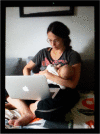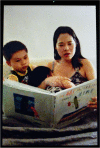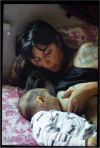Lactation in quarantine: The (in)visibility of human milk feeding during the COVID-19 pandemic in the United States
- PMID: 35313894
- PMCID: PMC8935117
- DOI: 10.1186/s13006-022-00451-2
Lactation in quarantine: The (in)visibility of human milk feeding during the COVID-19 pandemic in the United States
Abstract
Background: In response to the COVID-19 pandemic, billions of people were asked by their state and local governments not to go to work and not leave the house unless they had to. The goal of this qualitative study was to collect the lived experiences of a small group of parents and lactation professionals in the United States about what it was like to feed babies human milk under these conditions of quarantine.
Methods: This project is a social constructionist analysis of lactation narratives of 24 parents feeding their children human milk and 13 lactation professionals. They were interviewed remotely in 2020-21 via videoconferencing about their experiences and perspectives on the pandemic's effect on lactation. Additionally, photographs of 16 of the parents are provided to visualize their practices and how they chose to represent them.
Results: Four interrelated themes were identified in participants' narratives about how they experienced and made sense of human milk feeding during the pandemic: the loneliness of lactation during the pandemic, the construction of human milk as a resource to cope with the crisis, the (in)visibility of lactation amidst heightened multitasking, and the sense of connection created by human milk feeding at a time of unprecedented solitude.
Conclusions: While the pandemic may have had both positive and negative effects on lactation, it exposed continuing inequities in infant feeding, generating new forms of (in)visibility for lactating labor. Going forward, one lesson for policy and lawmakers may be that to adequately support lactation, they should take cues from the families who had positive experiences during the crisis. This would call for systemically overhauling of US laws and policies by guaranteeing: universal basic income, paid parental leave for at least six months, paid lactation leaves and breaks, affordable housing, universal health care, subsidized childcare programs, and equal access to high-quality, non-discriminatory, and culturally appropriate medical care-including lactation counseling-, among other initiatives.
Keywords: Breastfeeding; COVID-19; Donor human milk; Gender inequality; Human milk feeding; Lactation; Milk sharing; Pandemic; Parenting.
© 2022. The Author(s).
Conflict of interest statement
The authors declare that they have no competing interests.
Figures
Similar articles
-
The impact of the Covid-19 pandemic on North American milk banks.Matern Child Nutr. 2021 Oct;17(4):e13234. doi: 10.1111/mcn.13234. Epub 2021 Jun 30. Matern Child Nutr. 2021. PMID: 34190391 Free PMC article.
-
Pandemic policies and breastfeeding: A cross-sectional study during the onset of COVID-19 in the United States.Front Sociol. 2022 Nov 3;7:958108. doi: 10.3389/fsoc.2022.958108. eCollection 2022. Front Sociol. 2022. PMID: 36405376 Free PMC article.
-
"At the End of the Day, My Goal is to Help People Feed Their Babies Human Milk": A Qualitative Exploration of the Pumping Attitudes of Lactation Care Providers.J Hum Lact. 2023 Nov;39(4):711-719. doi: 10.1177/08903344231195628. Epub 2023 Sep 7. J Hum Lact. 2023. PMID: 37675870
-
Pumps: A Possible Tool to Promote More Equitable Lactation Outcomes.Yale J Biol Med. 2024 Mar 29;97(1):99-106. doi: 10.59249/MWYW7163. eCollection 2024 Mar. Yale J Biol Med. 2024. PMID: 38559458 Free PMC article. Review.
-
The effect of medications on the lactating mother and her infant.Clin Obstet Gynecol. 1980 Dec;23(4):1073-80. doi: 10.1097/00003081-198012000-00010. Clin Obstet Gynecol. 1980. PMID: 6160936 Review.
Cited by
-
Changes in Breastfeeding and Lactation Support Experiences During COVID.J Womens Health (Larchmt). 2023 Feb;32(2):150-160. doi: 10.1089/jwh.2022.0146. Epub 2022 Dec 26. J Womens Health (Larchmt). 2023. PMID: 36576992 Free PMC article.
-
Women's views and experiences of breastfeeding during the coronavirus disease 2019 pandemic: A systematic review of qualitative evidence.Matern Child Nutr. 2024 Oct;20(4):e13708. doi: 10.1111/mcn.13708. Epub 2024 Aug 9. Matern Child Nutr. 2024. PMID: 39120558 Free PMC article.
-
COVID-19 Public Health Restrictions and New Mothers' Mental Health: A Qualitative Scoping Review.Qual Health Res. 2024 Dec;34(14):1456-1471. doi: 10.1177/10497323241251984. Epub 2024 Jul 20. Qual Health Res. 2024. PMID: 39030700 Free PMC article.
-
Breastfeeding During COVID-19 Stay-at-Home Orders: Implications for Future Maternal Work Policies and Health Equity.Matern Child Health J. 2024 Nov;28(11):1961-1973. doi: 10.1007/s10995-024-03990-8. Epub 2024 Oct 8. Matern Child Health J. 2024. PMID: 39377945
-
Parents' experiences of infant and young child feeding during the COVID-19 pandemic in Ireland.Public Health Nutr. 2023 Dec;26(12):2652-2662. doi: 10.1017/S1368980023002343. Epub 2023 Oct 31. Public Health Nutr. 2023. PMID: 37905581 Free PMC article.
References
-
- Jardine FM. Human milk has no gender: 21st century breastfeeding language, presentation at the 14th Breastfeeding and Feminism International Conference: Roots and wing: Looking back, looking forward. J Hum Lact. 2019;35:606.
-
- Gribble K, Marinelli KA, Tomori C, Gross MS. Implications of the COVID-19 pandemic response for breastfeeding, maternal caregiving capacity and infant mental health. J Hum Lact. 2020;36(4):591–603. 10.1177/0890334420949514. Epub 2020 Aug 6. - PubMed
-
- KS Allers. 2020. Covid-19 restrictions on birth and breastfeeding: Disproportionately harming Black and Native women. . Accessed Nov 27, 2020. https://womensenews.org/2020/03/covid-19-restrictions-on-birth-breastfee...
MeSH terms
LinkOut - more resources
Full Text Sources
Medical
Miscellaneous



















